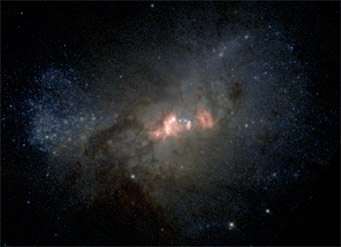One of the most interesting and important discoveries among galaxies in the last couple decades is that nearly all of them have a supermassive black hole in their centers. Moreover, the mass of the hole is tied very closely to the size and characteristics of the galaxy’s central bulge of old, yellow stars (especially to the stars' range of velocities).

The dwarf galaxy Henize 2-10, seen in visible light by the Hubble Space Telescope. The candidate supermassive black hole is in the tiny vertical streak between the two large, bright arcs near center. Click for larger view.
Amy Reines et al. / NRAO / AUI / NSF / NASA
Clearly, the hole and the bulge somehow “know” about each other — even though the hole has only about a thousandth as much mass and typically a billionth to a trillionth the diameter. A scale model: if the central bulge were several hundred miles across, the black hole at its center would be from a sand grain down to a microscopic dusk speck in size.
The standard theory right now is that the hole was so active early in the galaxy’s history that its jets and wind cleared all the star-forming gas out of the galaxy’s inner region, halting star formation there early, and that the number of stars that had already formed in the cleared-out area by then (today’s bulge) was somehow tied to the mass and activity strength of the hole.
But at this week’s American Astronomical Society meeting in Seattle, Amy Reines (University of Virginia) and her colleagues announced finding a new black hole that throws this well-established relationship completely out of whack. Is their find just a fluke or some kind of new, parallel trend?
Reines and her colleagues serendipitously discovered a black hole containing roughly 2 million solar masses in the star-forming dwarf galaxy Henize 2-10, located only about 30 million light-years from Earth in the southern sky. The black hole is roughly half the mass of Sagittarius A* (“A-star”), the one at the center of our Milky Way Galaxy. Yet Henize 2-10 has only a few percent the mass of the Milky Way, and it’s an amorphous blob of stars and gas lacking any semblance of a central bulge at all.
“Normally, supermassive black holes are found in much more massive galaxies, galaxies that have central bulges,” said Reines at a Monday press conference. “This finding is not only highly unusual, but it has implications for our understanding of the formation and evolution of black holes and galaxies.”
Reines and her colleagues were not looking for a supermassive black hole, especially since Henize 2-10 wasn’t expected to have one. She was using the Hubble Space Telescope and the Very Large Array (VLA) radio telescope to study the galaxy’s current rapid burst of star formation. But when the VLA data revealed a strong central radio source indicative of a black hole, she reviewed data taken several years ago by NASA’s Chandra X-ray Observatory. The galaxy’s central region shines much brighter in X-rays than expected. The pattern and amount of radio and X-ray emission is consistent with a black hole containing roughly 2 million solar masses accreting matter from its surroundings.
This “oversized” black hole has implications for one of astronomy’s most pressing chicken-or-egg questions: Which came first, supermassive black holes or their galaxies? Reines suggested that we may be witnessing the early stages of the formation and build-up of a supermassive black hole, a process that occurred many billions of years ago in much larger galaxies such as the Milky Way. The lack of a central bulge in Henize 2-10 shows that supermassive black holes can form before bulges do. But it’s unclear whether the hole preceded the formation of the galaxy itself.
Reines pointed out that studies of extremely distant quasars in the early universe also show black holes that are “too big” for their host galaxies. This suggests but does not prove that supermassive black holes could have formed before galaxies — perhaps from collapsing clouds of gas and dark matter before the first stars, or from the merger of smaller black holes left by those first stars. “We need more observations to constrain the theories,” she concluded.
More images are here.
 2
2
Comments
J Mahoney
January 12, 2011 at 6:56 pm
This looks more like a close interaction of two dwarf galaxies rather than one with such a massive black hole.
You must be logged in to post a comment.
J Mahoney
January 12, 2011 at 6:56 pm
This looks more like a close interaction of two dwarf galaxies rather than one with such a massive black hole.
You must be logged in to post a comment.
You must be logged in to post a comment.